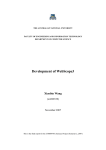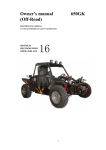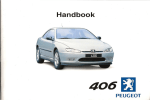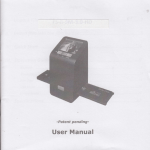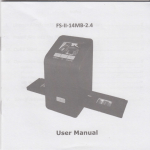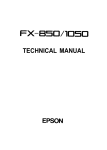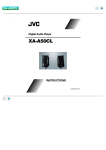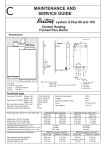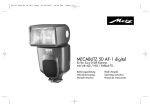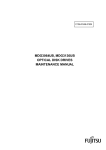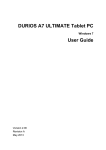Download USER`s MANUAL LIGHT AUTOMATIC RIFLE CAL. 7.62 m m
Transcript
F A L USER’s MANUAL LIGHT AUTOMATIC RIFLE CAL. 7.62 mm FADRlQUt NATlONALlE HtltSTAL Soci4tb Anonym ” ,1 u400 HEWAL (NLCIUM) 0 f I. INTRODUCTION The FN Light Automatic Rifle, colibre 7.62 mm N A T O , u s u a l l y k n o w n O S the “F. A. L.” or “L. A. R.“, has resulted from prolonged research and comoetitive trials made in various countries and unde; all types of climatic conditions. Fig. I This rifle, which has been adopted by many countries both within and outside NATO, was designed and made by FN to give the user a rifle which would combine all the essential qualities needed under modern fighting conditions, to a hitherto unequalled degree. This booklet is neither for the armourer nor the specialised officer: its purpose is to familiarise the user with a weapon which is new to him and to put sufficient knowledge at his disposal to enable him to use it with maximum efficiency. 3 I I. CHARACTERISTICS AND TECHNICAL DETAILS The FN Light Automatic Rifle is an automatic weapon, calibre 7.62 mm NATO, gas-operated and with a breech block which is mechanically locked before firing can take place. Rifle 1. Weights a) Rifle without magazine: 4.325 kgs (approx. 9.53 Ibs) b) Magazine (steel) empty: 250 g (8+ ots) c) Magazine (steel) filled 20 rounds Ball Ammn.: 730 g (1 lb 98 ozs) d) Barrel. approx. 800 g (1 lb 12a ozs) 2. Measurements a) Overall length . 1,090 mm (approx. 40”) 533 mm (approx. 21N) b) Barrel length . 553 mm (approx. 21$“) c) Sight radius . 3. System of operation: gas, with regulator and piston. 4. Method of feed: 20-round magazme. 5. Magazine housing : underneath the receiver. 6. 4 Ejection opening : right side of receiver. left side of receiver. 7. Cocking handle: 8. Chonge lever: left side of trigger frame. 9. Sights: adjustable, bocksight graduated from 200-600 metres, scaled by 100 m. 10. Rifling of barrel : 4 grooves, direction-right, p i t c h - l i n 305 m m (1 in 12”! 11. Cyclic rote of fire: 650-700 rpm. 12. Operational rate of fire, semi-automatic: up to 60 rpm. Cartridge 1. Colibre: 7.62 mm NATO (Fig. 2). 2. Weight of cartridge: (for ordinary ball round “SS 77”) approx. 24 g (0.86 oz). 3. Length of cartridge: 7 I mm (2.8”). 4. Weight of ordinary bullet: “FN SS 77”: 9.30 g (0.33 oz). 5. Powder charge: approx. 3 g (0.1 oz). 6. lnitiol Velocity (VO) in the “F. A. L.“: 840 m/set (2,754 ft/sec). 7. Muzzle Energy (EO) in the “F. A. L.“: 335 kgm (2,422 ft.lbs). 8. Remaining Kinetic Energy at 600 metres (656 yds): 100 kgm (723 ft.lbs). N. 6. For further technical information and ballistical chorocteristics, also firing tables, refer 5 to FN booklet for Ammunition calibre 7.62 mm NATO, or other handbook on thk subject. Fig. 2 FN 7.62 mm NATO cartrldge wtth SS 77 bullet 6 III. FUNCTIONING 1. COCKING Before firing, the breech block mechanism is forward, with the safety applied (change lever set at ‘5”). Insert a filled magazine obliquely in the housing under the receiver, swing it from front to rear and push fully home: the magazine is then. secured in the rifle at both front and rear. Pull the cocking handle, on the left side of the receiver, fully to the rear, then let it go forward: a cartridge is thus introduced into the chamber; the rifle is loaded and cocked. To fire, set the change lever either at “R” for semi-automatic fire, or at “A” for automatic fire. 2. REAR MOVEMENT OF THE MECHANISM Pressing the trigger fires the shot. When the bullet passes the gas port in the barrel, port of the combustion gases penetrate the regulator and thence into the gas cylinder. The. piston is projected to the rear, strikes the breechblock slide, which is also driven rearwards. After recoiling a few millimetres, the ramps of the slide force the rear part of the breech block to rise, thus lifting it out of engagement with its locking 7 shoulder in the receiver. The mechanism is then unlocked. The recoil of slide dnd breech block continues, the extractor removes the spent case from the chamber: extraction is completed; then the hammer, pushed by the slide, is forced to pivot to the rear. As recoil continues, the base of the spent case contacts the ejector, an integral part of the receiver; the case is then thrown out of the gun to the right, through the ejection opening. buring this rear movement, the return springs, housed in the butt, are compressed by the slide rod, hinged to the rear of the slide. The piston has returned to its forward position, as its spl’ing relaxed. 3. FORWARD ACTION OF THE MECHANISM The return springs, compressed during the rear movement of the mechanism, now relax and drive the breech block assembly forward. The breech block pushes the next cartridge towards the chamber, while the hammer is held in the cocked position by the safety sear: the front of the breech block contacts the rear portion of the barrel; the cartridge is chambered and the base of its case seized by the extractor claw. The slide acts on the upper shoulder of the breech block and forces its rear end downwards, causing its lock shoulder to engage in the locking recess in the receiver. The mechanism is now lacked. The slide continues its forward movement alone: towards the end of its course, the safety sear is tripped by the shoulder on the rear left underside of the slide, which causes the sear to pivot and the hammer to be released; the rear end of the firing 8 pin protrudes beyond the rear face of the slide, when the front face of the slide is.fully home. In automatic fire, it is the safety sear which releases the hammer and thus causes the shot to be fired, because the trigger sear is not in action in this case, except for the first shot of each burst of fire. In semi-automatic fire, it is the trigger sear which finally releases the hammer, after it has first been released by the safety sear; the mechanism has been so designed that the trigger must be released, then pressed again, to permit the following shot to be fired (see 4 below). 4. CHANGE LEVER The lever arm can occupy one of the three following positions: a) An uppermost position “5” when the rifle is at safe: in this position, if the trigger is pressed, it is impossible to fire because the rounded part of the change lever arm is over the trigger platform, preventing it from rising to engage the tail of the sear. b) A front position “A”, which sets the mechanism at automatic fire: before firing the rear tip of the trigger is now so positioned in relation to the deeper bent in the change lever axis that pressing the trigger causes the sear to pivot upwords: the nose of the sear is consequently disengaged from the hammer bent and firing takes place. In addition, the nose of the trigger sear has been swung downwards so that it cannot contact the hammer, which is controlled by the safety sear only, so long as the trigger is not released; OS firing depends on the safety sear, this frees 9 the hammer each time the mechanism closes after the breech is completely locked: firing is automatic, When the firer releases the trigger, the nose of the sear rises, catches hold of the hammer, which then pushes the sear slightly to the rear; this positions the tail of the sear over the heel of the trigger and the mechanism is then cocked, ready to fire the next burst. c) A rear position “R”, which sets the mechonism at semi-automatic (single shot); the rear tip of the trigger is now against a shallower bent in the change lever than in position “A”, pressing the trigger therefore pivots the sear to a lesser degree so that after the first shot has been fired, the hammer will be caught by the sear. This moves slightly forward under the action of its spring and is thus placed in front of the heel of the trigger, i.e. no longer in contact. Firing another cartridge is therefore impossible if pressure on the trigger is maintained. To continue firing, the trigger must be released; when this is done, the hammer turns slightly under action of its spring; OS it is in contact with the sear, it pushes the sear towards the rear so that the tail of the sear comes over the heel of the trigger; pressure on the trigger will now fire the second shot, and so on. Note : If automatic fire is not required, the change lever can be removed and another change lever fitted with indent for semi-automatic fire only, i.e. with 2 instead of 3 settings. Any soldier can easily make this substitution. 10 5. HOLDING OPEN DEVICE . When the magazine is empty, its platform pushes the holding open device upwards, in the pathway of the breech block, which is thus held to the rear, and the firer knows that his magazine is empty. After a filled magazine has been inserted, depress the lever of the holding open device so that the breech block is released and can continue its forward movement. 11 IV. HANDLING 1. FILLING MAGAZINE a) With Magazine Filler Each rifle is usually supplied with a magazine filler. - Fit the magazine filler over the mouth of the magazine, with the guides for the loading clip on the side of the magazine rib Fig. 3 12 - Insert a loaded clip into the reor guide of the magazine filler (fig. 3). - With the thumb as near as ‘possible to the clip, force the rounds down into the magazine. b) Without a Mogarine Filler - If the rounds are in clips, take them out. - Insert the cartridges one by one into the magazine, with the base of the round to the rib of the magazine. c) N o t e - After filling a magazine, particularly when a magazine filler has not been used, it is advisable to check the positioning of the . cartridges in the magazine by pressing down with the thumb on the last round inserted. - In the event of one or more cartridges not sliding freely inside the magazine (jamming of the point of a round against the front wall), a correct positioning of all the cartridges can be obtained by striking the rear wall or on the bottom of the magazine lightly with the palm of the hand. 2. CHARGING - Insert a filled magazine front end foremost into the magazine housing (fig. 4). - Swing the magazine into position and push fully home. 13 Fig. 4 - The magazine is then secured at the rear by the magazine catch. 3. LOADING - Take hold of the pistol grip with the right hand. - With the left hand, pull the cocking handle (on the left side of the receiver) to the rear and then release it. - The forward movement ‘of the breech block will have extracted a cartridge from the magazine, chambered it and then locking of the moving parts will hove taken place automotically. The rifle is now ready to fire. Note: During charging and loading operations, the rifle will be kept at safe (Change lever set at “5”). 14 4. RELOADING After the lost round in the magazine has been fired, the holding open device, operated by the magazine platform, keeps the mechanism to the rear (see page 11). - Press the magazine catch (fig. 5). - Remove the empty magazine, swinging it forwords. - Insert 0 filled magazine. Depress the lever of the holding open device (fig. 6); the breech block will then move forward. Fig. 5 15 Fig. 6 The rifle is now ready to fire again. 5. UNLOADING - Put the rifle at safe (change lever set at “S”). - Remove the magazine. - Pull the cocking handle fully back to extract and eject the cartridge in the chamber. - Release the cocking handle and let the mechanism go forward. 16 - 6. FIRING SINGLE SHOT - Insert a filled magazine. - Use the tip of a cartridge to push the plunger in the gas plug fully down and hold it in this position (fig. 22). - Turn the cartridge and the gas plug 180” so that the letter “G” appears on top, instead of the letter “A”. - Let the plunger return to its housing (the notch in the plug is towards the bottom). - Carry out the loading operations (see page 14). - After firing each shot, repeat the loading operations. 7. FITTING THE BLANK FIRING DEVICE - This device is to be screwed on the tapped end of the combined device (fig. 7). 8. GAS REGULATION The purpose of the gas regulator is to ensure correct functioning of the rifle with maximum gas escape, or, in other words, the minimum intake 17 necessary for normal functioning, without causing undue wear on the various parts of the mechanism. Turning the gas regulator to the right (clockwise) reduces the opening by which gas escapes, thus increasing the quantity or “intake” gas used to drive the piston to the rear. Turning the gas regulator to the left (anticlockwise) causes the opposite effect: gas escape is increased and the balance available to work the piston is decreased. By a system of “clicks” and engagement of the gas regulator spring, the regulator has 13 different positions (12 “clicks” to open fully). To make setting in any given position easier, figures are engraved on the gas regulator, the figure 1 corresponding to the completely closed position and one figure for every 2 “clicks” opening. Example: when the figure 5 is opposite the gas hole, the gas regulation corresponds to 8 “clicks”. o) Method of gas setting There are several different ways of finding the correct adjustment but we suggest the following method, which has, we think, proved itself the best :- Insert an empty magazine in the rifle; - All firing is carried out by inserting the cartridges by hand, one by one into the empty magazine, through the ejection opening. - The correct setting is determined by the point at which the holding open device engages the mechanism and holds it to the rear, or fails to do this. 18 Fig. 8 Fig. 9 b) Operations O p e r a t i o n 1 . A f t e r screwing the gas regulator right down against the gas block (fig. 8), unscrew by one complete turn so that the figure 7 is in line with the axis of the gas escape hole (fig. 9). This is the fully open position and, when a round is fired, causes a “short recoil”, identifiable by the holding open device failing to engage the mechanism. Operation 2. Close the gas regulator click by click and fire a cartridge after each adjustment until the breech block is held to the rear by the holding open device. Operation 3. Now verify by firing several cartridges, one after the other, in the way described above. Operation 4. If any shot results in a failure of the holding open device to engage the mecha19 nism, repeat Operation 3, after closing the gas regulator by one click. If necessary, repeat Operation 4 Operation 5. until 5 consecutive shots result in the holding open device holding the mechanism to the rear 5 times. Operation 6. The gas setting for the rifle is now determined, but it is always advisable to allow a small reserve of “working” gas by reducing the gas escape by two additional clicks. Note - If the special spanner (fig. 10) is not available, adjustment can be made with the point of a cartridge (fig. 1 I), or even by hand. F i g . IO Fig. 1 1 - Before leaving the factory, every rifle has been adjusted for correct gas setting. - In principle, the soldier should not alter the gas setting; this operation ought to be done in the presence of the unit armourer, or an instructor. - In practice, the force with which the spent cortridge case is ejected gives on invaluable indi20 An ejection of cases cation of the gas setting. to a distance of 1.50-2 m from the rifle and at f 45” in relation to the barrel axis can be Violent ejection shows considered normal. that too much gas is being admitted and, in this event, the gas escape must be increased. On the contrary, weak ejection shows that insufficient gas is being taken in and, in this case, the gas escape should be reduced. 9. ZEROING The rifle is zeroed, i.e. the sights are correctly adjusted, before issue to the user but it may require some attention to correct for elevation and direction to suit individual needs. Such correction must be done by a qualified armourec, or on instructor, who will have the special tools to do this. a) Correction for Elevation Errors in elevation are corrected by screwing the foresight up or down. If it is screwed up, the M. P. I. will be moved down and vice-versa. A spring detent locates and holds the foresight in position, which forms a clicking device with the 16 equal divisions serrated under the foresight collar; this assists the armourer when calculating movement of the M. P. I. Moving the foresight 1 division (or click) is equal to a variation in M. P. I. of 1 cm at 100 metres (approx. 0.39” at 109 yds). b) Correction for Direction Errors in direction are corrected by moving the backsight to the right or left. 21 If the M. P. I. is to the right of the point sighted, the screw on the left of the sight is loosened and the screw on the right is screwed up, thus moving the sight laterally along its dovetail from Tighten the screw on the left. right to left. When the correction has been made, and before shooting, tighten both screws. If the M. P. I. is to the left of the point sighted, the sight must be moved from left to right. A movement of 1 division (or click) is equal to a variation in M. P. I. (to right or left) of 1 cm at 100 metres (approx. 0.39” at 109 yds). 10. STOPPAGES AND IMMEDIATE ACTION The FN Light Automatic Rifle is unlikely to be affected by variations in normal ammunition. Obviously, this means good quality ammunition because a bad cartridge will give rise to stoppages, whatever the weapon that fires it. Stoppages are generally of two types:1. Those caused by fouling, due to the user’s negligence, or ignorance of his rifle, or lack of lubrication (modern powders of good quality cause very little fouling). 2. Those caused by some mechanical deficiency (less frequent). A mechanical stoppage, other than that caused by an empty magazine, can usually be remedied by taking immediate action, without stopping to investigate its cause. 22 Procedure for immediate action - Remove the magazine; - Pull the cocking handle fully to the rear and release; do this twice; - Replace the magazine; - Load (recock the rifle by pulling the cocking handle to the rear and releasing so that a new round is fed into the chamber); - Resume firing. If the stoppage recurs, consult the armourer or instructor to find out the cause. 23 V. GRENADE LAUNCHING The F. A. L. is equipped with a combined device, serving as both flash-hider and grenade-launcher; with this fitment, anti-tank and anti-personnel grenades can be launched with great accuracy. . Fig. 12 1. CARTRIDGE A special type of ammunition is used, generally known as a propulsive, or grenade, cartridge. This cartridge has no bullet and the mouth of the case is closed by a “star” crimping which is waxed to ensure complete tightness (fig. 12). 24 2. HANDLING I. Put the rifle at SAFE. 2. Unload (chop. IV, 5). 3. Set the rifle for firing single shot (see chapter IV, 6). 4. With the left hand, cock the rifle. With the right hand, insert the propulsive cortridge in the chamber (fig. 13). Let the mechanism go forward (it is easier if the muzzle of the gun is held downwards). Fig. 13 5. Put the grenade on the launcher and make sure that it is fully home 6. Releose the safety from the rifle and, as required, remove the grenade safety. The rifle is then ready to fire. 25 3. FIRING POSITIONS 0) - Direct fire (fig. 14) - Grasp the middle of the handguard firmly with the left hand. - Hold the pistol grip firmly with the right hand, with the index finger securely in front of the trigger. - Hold the butt under the right armpit, n e v e r lean it on the shoulder. For the 3 usual positions (standing, kneeling, prone) the method of holding the rifle is the some. Fig. 14 26 N. 6.: A sling can be used to help take the recoil but this is left to the discretion of the user. b) Indirect fire (fig. 15) Fig. 15 - Dig the heel of the butt into the earth, with the pistol grip uppermost, i.e. towards the firer. - Incline the rifle at the required angle. - Hold the foot down on the front of the butt to prevent it from moving out of position. 27 Note: So far as possible, it is advisable to avoid positioning the butt against any hard surface, such as concrete, rock, etc. This is particularly important for indirect fire from the prone position, where the soldier naturally tends to anchor the fore part of the butt to avoid the effects of recoil. , :. 28 VI. FIELD STRIPPING The soldier should know the field stripping routine so well thot it con be carried out in darkness. For this stripping, he will need to use the nose of a cartridge; no other tools are required. - Remove the magazine. - Cock the mechanism to ensure that the rifle is clear and there is no round left in the chamber, allow the breech block to go forward and set the change lever at safe, leaving the hammer cocked. 1. STRIPPING THE MECHANISM - Press the body locking lever (on the left side) as far as possible upwards; at the same time, press the butt/trigger frame group downwards, which will swing the rifle open like a shotgun (see fig. 16). - Remove the slide-breech-block assembly by taking hold of the slide rod hinged to the slide (fig. 17). 29 Fig. 16 Fig. 17 2. REMOVING THE COVER Slide the receiver cover to the rear (fig. 18). 30 Fig. 18 3. SEPARATING THE SLIDE FROM THE BREECH BLOCK Disengage the fore part of the breech block from the slide and continue to separate with a levering movement against the rear part of the breech block, keeping the thumb on the rear end of the firing pin (fig. 19). 4. REMOVING THE FIRING PIN Exert pressure on the rear end of the firing pin and push out its retaining pin. If the pin does not fall out easily, use the nose of a cartridge to push it out (fig. 20). 31 Fig. 19 Fig. 20 When the retaining pin has been removed, the firing pin will come out of its housing under action of its spring (fig. 21). 32 Fig. 21 5. REMOVING THE GAS PiUG Use the nose of a cartridge to press in the plunger (fig. 22), then turn the gas plug a quarter turn in a clockwise direction (fig. 23). Fig 22 Fig. 23 33 In this position, the plug will be pushed from its housing by the piston spring. 6. REMOVING THE PISTON Remove the piston and its spring from the gas cylinder (fig. 24). Fig. 24 Separate the piston spring from the piston rod (fig. 25). Fig. 25 34 Note: There is no need for the soldier to strip the extractor. It is necessary to use a cartridge for this, or a special tool, and it is normally done by the armourer when making o perio?Jic inspection. 7. ASSEMBLY AFTER FIELD STRIPPING - Replace the piston spring on the piston rod (fig. 25). - Replace the piston and its spring in the gas cylinder (fig. 24). - Insert the gas plug, compressng the piston spring, with the big end of the plunger turned towards the barrel (fig. 23). - When the gas plug is fully home, rotate it oneeighth of a turn, so that the letter “A” moves upwards. - Use the nose of a cartridge to push the plunger and rotate so that the letter “A” appears uppermost (fig. 22). - Replace the firing pin spring and the firing pin in the breech block (fig. 21); compress the spring by working the firing pin and replace the pin. - Replace the breech block in the slide, inserting the rear part obliquely in the slide (fig. 19). Exert pressure on the breech block so that the firing pin spring is slightly compressed and the breech block is swung downwards into its correct position in the slide. - Insert the ribs of the cover in the corresponding grooves in the receiver (fig. 18) and slide the cover fully forward. - Replace the mechanism in the body, inserting the ribs of the slide in the corresponding 35 grooves in the receiver. When this is done, the breech block should be in its forward position (fig. 17) and the muzzle of the rifle pointing downwards; the mechanism will then fall into position correctly. - Close the rifle, still holding the muzzle downwards, to prevent any possibility of the slide rod protruding. 36 VII. CLEANING AND MAINTENANCE 1. GENERAL REMARKS It must be emphasized that all automatic weapons require constant cleaning and maintenance and that most of the stoppages mentioned elsewhere are the result of the soldier’s negligence or lack of knowledge of his weapon. All weapons, whether automatic or repeating rifles, should be cleaned at the end of a day’s firing and special core must be taken after firing with blank cartridges. 2. MAINTENANCE OF THE RIFLE a) Maintenance by the soldier The FN Rifle cal. 7.62 mm only needs to be partially stripped for this maintenance (field stripping); maintenance routine is 0s follows:- Use the barrel cleaning brush, oiled with the special rifle bore oil provided, and pass through the barrel several times: - Follow this by pulling through two or three dry rags; - Clean the chamber with the cleaning brush provided for this purpose; 37 Clean the slide, rear of the barrel and inside the body; Clean the breech block, firing pin and its housing; Clean underneath the extractor claw, without stripping it; Remove the gas plug, the piston and its spring and carefully clean these parts, as they are exposed to gas fouling; Clean the gas cylinder and wipe with a slightly oiled rag; this rag should also be passed through the barrel; Very slightly oil the moving parts of the mechanism. Inspection and maintenance by the unit armower It is essential that the rifle should be examined periodically by the armourer, who will check that it is being properly cared for by the user. All components of the rifle will then be checked for correct functioning. When this examination is made, the following special cleaning and inspection operations will also be carried out:- Cleaning the exhaust port in the gas cylinder; - Stripping and cleaning the extractor; - Checking the gas setting; ’ - Checking the sight and correcting, if necessary. 38 3. COMPLETE CLEANING OF BARREL AND GAS CYLINDER The barrel and gas cylinder must be cleaned regularly so that they never get into such a state that the use of abrasives is necessary; all abrasive material such as emery paper, sand, etc., is always harmful. The full cleaning of barrel and gas cylinder should be done unhurriedly, when circumstances permit, 0s follows: Wash the barrel, using barrel brush, or sponge, steeped in special oil. Wash the inside of the front part of the gas cylinder and gas block, using the brush for cleaning the chamber and the special oil. After the barrel and gas cylinder have been thoroughly cleaned in this way, dry carefully, using clean rags. After drying, the ragusually white service flannelette-should come out of the barrel and gas cylinder unstained. After drying, slightly oil the barrel (bore and chamber) and the gas cylinder. Dry the outside of the barrel and polish with a greasy rag. The pieces of flannelette for this cleaning will usually be cut to the tollowing measurements: length approx. 120 mm, width approx. 60 mm (about 5” x2+“). For possing through the barrel, use an unfolded piece, for cleaning the gas cylinder, double it over to give a 60x60 mm square before inserting in the loop of the cleaning rod or pullthrough. Rags or cotton waste can be used for cleaning the remaining parts of the rifle. 39 Note: The inside of the barrel and inside of front half of the gas cylinder come into direct contact with the combustion gases and are also submitted to friction; they consequently require more care and attention. Other components are protected against oxidising by phosphating (parts of the mechanism and receiver) and the piston and gas plug are hard chromed. Precaution after firing To be on the safe side, particularly in hot climates, and to make subsequent cleaning of barrel and gas cylinder easier, the user is strongly advised to take the following preventive measure: Immediately ofter firing, before leaving the firing range or scene of manceuvres, clean barrel and gas cylinder by wiping with a rag steeped in special oil (Rifle bore oil). This precaution has the effect of:Neutralising the harmful effect of any fouling caused by residue of powder gases; Preventing the formation of carbon deposits in the gas cylinder ond gas block; Allowing the usual cleaning operations to be postponed for at least 24 hours, without causing any damage. Within 48 hours of carrying out this precaution, the rifle should be completely cleaned as indicated in paragraphs 2 and 3. 40 4. PREPAkATlON OF RIFLE BEFORE FIRING The L. A. R. functions with very little or procticolly no lubrication. Before firing, wipe off any oil remaining on barrel and gas cylinder surfaces; if the piston and chromed part of the gas plug have been slightly oiled, dry clean these too. The tabulation given below gives on one side the list of parts which can be slightly oiled, on the other the list of parts which require no oiling and which, in some cases, can be adversely affected, if oiled. Components, or parts of components, which will not be oiled before firing Components, or ports of components, which wtll be very slightly oiled OILED - Inside breech block slide. - Breech block, ot locking shoulders. - Body, at bottom ond olong guide grooves for slide. - Holding open device. LEFT DRY - Barrel. - Gos cylinder. - Piston. - Gos Plug. i ) chromed ports - Outer surface of slide. - Front block. face of breech - Mogorine and plotform. - M a g a z i n e catch - Sights. 41 INDEX I. II. I I I. IV. . . . . . . 3 .... . . . . . . . . . Functioning . I. Cocking . . . . 2. Rear movement of the mechanism . 3. Forward action of the mechanism . . . 4. Change lever . . . . 5. Holding open device . . . 4 Introduction Characteristics ond Technical Details Hondling . . . . I. Fillbtg M a g a z i n e ......... a) With magazine filler ...... b) Without magazine filler . . . . . . ....... c) Note on checking .......... 2 . Charging 3. Loading ............ ........ 4 . Relooding Unloading ........... ;: Firing single shot ......... . . . Fitting the blonk firing device . :: Gas regulation . . . . . . . . . . a) Method of gas setting ...... b) Operations .......... 9 . Zeroing sights . . . . . . . . . . .... a) Correction for elevation ..... b) Correction for direction 10. Stoppages and immediate action .... V. Grenade Launching I. Cartridge . . 2. Handling . . 3. Firing positions a) Direct fire . b) Indirect fire . . * 7 : : 11 12 12 12 13 13 13 I4 15 I6 17 17 I7 18 :: 21 21 22 tl: 25 26 26 27 43 VI Field Stripping . . . . . . 1 . S t r i p p i n g t h e m e c h a n i s m . ‘. 2. Removing the cover . 3. Separating the slide from the ‘breech block 4. Removing the firing pin . . 5. Removing the gas plug . . . . . 6. Removing the piston ... 7 . A s s e m b l y a f t e r f i e l d s t r i p p i n g . .’ : VII. Cleoning and Maintenance . . . General remarks . 2. Maintenance of the rifle : : : 1 : a) Maintenance by the soldier b) Inspection and Maintenance by the unit armourer . . . 3. Complete cleaning of barrel and gas cylinder 4. Preparation of rifle before firing ... I. 44











































